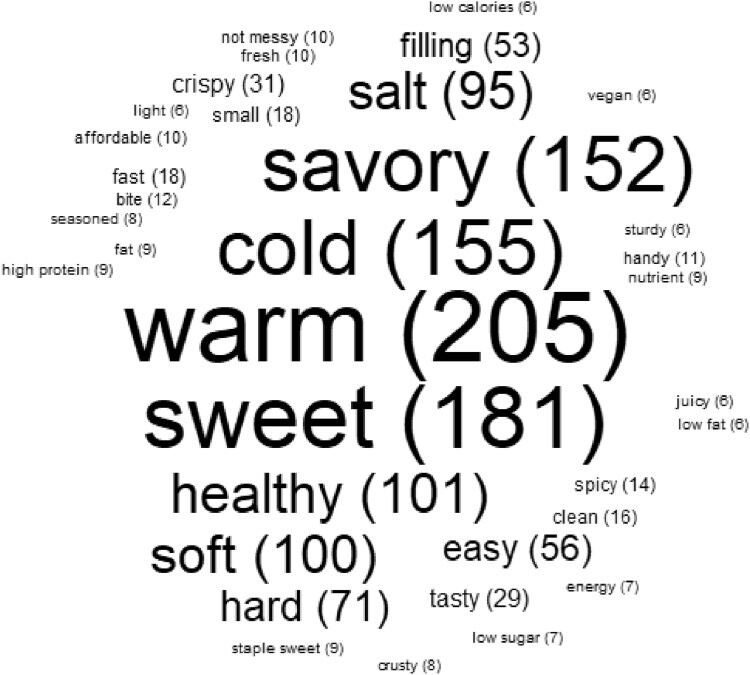Numerous studies have concluded that most of a consumer’s caloric intake stems from calories consumed while snacking, playing a major role in today’s obesity crisis. And with the ‘snackification’ trend taking hold – especially prevalent over the past several months as people sought solace and strength to deal with the pandemic – emphasis is increasingly being placed on finding ways to support people to snack more healthily.
To this aim, a team of Dutch scientists set out to get a better understanding of what the consumer considers to be the ‘utopian’ snack.
“We aim to better understand what an ‘ideal’ snack should be like by generating conceptions of this ‘ideal snack’. This way, we will shed more light on what people think about an attractive snack without contaminating it with preconceptions about the perceived (un)healthiness of snacks,” they wrote.
“In addition, we will compare people's ideal snack conceptions with their notions of healthy and unhealthy snacks. The obtained results may eventually be used as a starting point for the design of healthy and appealing snack foods, by taking ideal snack conceptions into account while at the same time adhering to healthy diet guidelines.”
Participants – ranging in age between 18 and 81 recruited from public places, local high schools, university campuses and via social media – were asked to “Imagine that you are on the go (for example, from work to home, or from school to home) and feel like a snack. What would this be then? Describe your ideal snack. You can think of what this snack looks like, how it tastes, whether it is hot/cold, hard/soft, sweet/salty, anything you think about when you think about this snack”.
They were also asked to rate the snack on healthiness – from 1 (very unhealthy) to 5 (very healthy) – and provide three words that came to mind when thinking of a healthy/unhealthy snack.
Snack tailoring
According to the study – to be published in the September 2020 edition of Appetite – the ‘ideal’ snack is not a simple and straightforward concept, constrained by a number of idiosyncratic conceptions that should allow for different sensory experiences or individual tailoring.
Today’s consumer wants a healthy snack with sensory characteristics that fits their personal preference.
The study noted unhealthy snacking behaviour is primarily driven by habit strength rather than conscious intentions to eat unhealthily. It has also been propelled by today’s so called ‘obesogenic’ environment, which is fuelled by marketing messages that suggest that high caloric features – such as sweet, salty and fat – represent tastiness.
While an increasing number of consumers say they want healthier snacks, the majority still place taste as the main purchasing motivator.
Adding to temptation is the perception that ‘unhealthy’ foods are considered to be more satisfying than healthy foods. For instance, consumers who were asked to sample a ‘healthy’ chocolate-raspberry protein bar reported less satiety once it was consumed. They also ate more of the bar compared to when it was presented as tasty.
Importantly, though, this effect was driven by what consumers were told about the bar. Only those who thought the choice for a ‘healthy’ bar was imposed felt hungrier after eating it. This effect was absent when they chose the bar themselves.
Similar observations on healthy choices being imposed rather than autonomous have been made, suggesting that when people focus on the health facets, they tend to experience less pleasure from consumption.
However, the association of unhealthy with tasty is not universal.
A 2013 study among French consumers revealed the complete opposite in that unhealthy foods were associated with bad taste and healthy foods were perceived as tasty.
One explanation is the French do not consider healthy food as a moral obligation. However, the study did again reveal that snacks ‘marketed’ as healthy or unhealthy could influence preference.
The top five criteria
The study found the subjects used different words to describe ‘ideal’, ‘healthy’ and ‘unhealthy’ snacks, dividing them into three distinct snack categories.
Specifically, ideal and healthy snacks were described with a multitude of features whereas unhealthy snacks were more uniformly described as ‘fat’ or containing ‘sugar’ leading researcher to conclude that people seem to have stronger associations with unhealthy snacks than with healthy and ideal snacks.
The five most frequently named descriptions were ‘warm’, ‘sweet’, ‘cold’, ‘savoury’ and ‘healthy’.

For a healthy snack, the five most frequently used words were ‘tasty’, ‘low sugar’, ‘healthy’, ‘vitamins’ and ‘low calories’.

The five most frequently named words for an unhealthy snack were ‘fat’, ‘sugar’, ‘salt’, ‘tasty’ and ‘harmful to health’.

Taste remains king
A wealth of research to-date clearly shows that people have strong existing conceptions about healthy and unhealthy snack choices and, for many, the healthier route is associated with giving up on pleasure and taste.
However, the Dutch scientists concluded the labels of healthy and unhealthy do pertain so much to particular food characteristics but to what should be accomplished by consumption, that is, the consequences for health.
“When attempting to synthesise the apparent contradictory features of health and taste, it is almost impossible to avoid these moralised associations of healthy and unhealthy,” they wrote.
Interestingly, they noted that, even though ‘tasty’ was often mentioned as an association with unhealthy snacking, it was named in the top 15 words to describe the ideal snack and mentioned almost equally as often as healthy snacks, underlying the importance of taste as a driving force in food choice.
This suggests that an ideal snack should be tasty but that being tasty does not equal unhealthy. It is also a quality assigned to healthy snacks.
Study
The snack that has it all: People's associations with ideal snacks
Authors: Caroline Schlinkert, Marleen Gillebaart, Jeroen Benjamins, et al
Appetite, Volume 152, 1 September 2020, 104722



